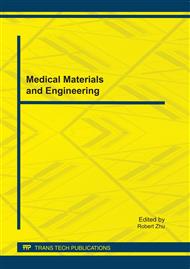[1]
Shihomo TAKADA, Takashi INOUE, Kuniyasu NIIZUMA, Hiroaki SHIMIZU, Teiji TOMINADA, Hemosiderin detected by T2-Weighted magnetic resonance imaging in patients with unruptured cerebral aneurysms: indication of previous bleeding, Neural Med Chir (Tokyo). 51 (2011).
DOI: 10.2176/nmc.51.275
Google Scholar
[2]
Claudia Schlimper, Oliver Nemitz, Ulrich Dorenbeck, Jasmin Scorzin, Ross Whitaker, Tolga Tasdizen, Martin Rumpf, Karl Schaller, Restoring three-dimensional magnetic resonance angiography images with mean curvature motion, Neurological Research. 32 (2010).
DOI: 10.1179/016164110x12556180206077
Google Scholar
[3]
Nicolaas A. Bakker, Henrietie E. Westerlaan, Jan D. M. Metzemaekers, J. Marc C. Vandijk, Omid S. Eshghi, Jan Jakob A. Mooij, Rob J. M. Groen, Feasibility of magnetic resonance angiography (MRA) follow-up as the primary imaging modality after coiling of intracranial aneurysms, Acta Radiol. 10 (2010).
DOI: 10.3109/02841850903436642
Google Scholar
[4]
Takao H, Murayama Y, Ishibashi T, Saguchi T, Ebara M, Arakawa H, Irie K, Iwasaki K, Umezu M, Abe T, Comparing accuracy of cerebral aneurysm size measurements from three routine investigations: computed tomography, magnetic resonance imaging and digital subtraction angiography, Neurol Med Chir(Tokyo). 50 (2010).
DOI: 10.2176/nmc.50.893
Google Scholar
[5]
Jean-Christophe Ferre, Beatrice Carsin-Nicol, Xavier Morandi, Michel Carsin, Axel de Kersaint-Gilly, Jean-Yves Gauvrit, Hubert-Armand Desal, Time-of-flight MR angiography at 3 T versus digital subtraction angiography in the imaging follow-up of 51 intracranial aneurysms treated with coils, European Journal of Radiology. 72 (2009).
DOI: 10.1016/j.ejrad.2008.08.005
Google Scholar
[6]
Wu Qiang, Qi Hongyang, Li Zhenyu, Wang Xiahong, Application of MRA in the diagnosis of intracranial aneurysms, Chinese Journal of Practical Nervous Diseases. 13 (2010) 15-17.
Google Scholar
[7]
Nam Lee, Jin Young Jung, Seung Kon Huh, Dong Joon Kim, Dong Ik Kim, Jinna Kim, Distinction between intradural and extradural aneurysms involving the paraclinoid internal carotid artery with T2-Weighted Three-Dimensional fast spin-echo magnetic resonance imaging, J Korean Neurosurg Soc. 47 (2010).
DOI: 10.3340/jkns.2010.47.6.437
Google Scholar
[8]
Jean-Franc¸ois Vendrell, Nicolas Menjot, Vincent Costalat, Endovascular treatment of 174 middle cerebral artery aneurysms: clinical outcome and radiologic results at long-term follow-up, Radiology. 253 (2009) 191-198.
DOI: 10.1148/radiol.2531082092
Google Scholar
[9]
Pyysalo LM, Keski-Nisula LH, Niskakangas TT, Koehoeroe VJ, Ohman JE, Long-term MRI findings of patients with embolized cerebral aneurysms, Acta Radiol. 52 (2011) 204-10.
DOI: 10.1258/ar.2010.100127
Google Scholar
[10]
Min A. Yoon, Eunhee Kim, Bae-Ju Kwon, Muslinoma and muslin-induced foreign body inflammatory reactions after surgical clipping and wrapping for intracranial aneurysms: imaging findings and clinical features, J Neurosurg. 112 (2010) 640–647.
DOI: 10.3171/2009.7.jns081625
Google Scholar
[11]
T.J. Kaufmann, J. Huston, III, H.J. Cloft, J. Mandrekar, L. Gray, M.A. Bernstein, J.L. Atkinson, D.F. Kallmes, A prospective trial of 3T and 1. 5T time-of-flight and contrast-enhanced MR angiography in the follow-up of coiled intracranial aneurysms, American Journal of Neuroradiology. 31 (2010).
DOI: 10.3174/ajnr.a1932
Google Scholar
[12]
Ming-Hua Li, Ying-Sheng Cheng, Yong-Dong Li, Large-cohort comparison between three-dimensional time-of-flight magnetic resonance and rotational digital subtraction angiographies in intracranial aneurysm detection, Stroke. 40 (2009) 3127-3129.
DOI: 10.1161/strokeaha.109.553800
Google Scholar
[13]
N. Anzalone, MR angiography follow-up of aneurysms treated with coils: is there a need for the use of gadolinium? AJNR Am J Neuroradiol. 30 (2009) 1531.
DOI: 10.3174/ajnr.a1734
Google Scholar
[14]
N. Anzalone, F. Scomazzoni, M. Cirillo, C. Righi, F. Simionato, M. Cadioli, A. Iadanza, M.A. Kirchin, G. Scotti, Follow-up of coiled cerebral aneurysms at 3T: comparison of 3D time-of-flight MR angiography and contrast-enhanced MR angiography, AJNR Am J Neuroradiol. 29 (2008).
DOI: 10.3174/ajnr.a1166
Google Scholar
[15]
T. Kau, J. Gasser, S. Celedin, E. Rabitsch, W. Eicher, E. Uhl, MR angiographic follow-up of intracranial aneurysms treated with detachable coils: evaluation of a blood-pool contrast medium, AJNR Am J Neuroradiol. 30 (2009) 1524 –30.
DOI: 10.3174/ajnr.a1622
Google Scholar
[16]
A.J. Martin, S.W. Hetts, W.P. Dillon, R.T. Higashida, V. Halbach, C.F. Dowd, M.T. Lawton and D. Saloner, MR imaging of partially thrombosed cerebral aneurysms: characteristics and evolution, American Journal of Neuroradiology. 32 (2011) 346-351.
DOI: 10.3174/ajnr.a2298
Google Scholar
[17]
Ferns SP, van Rooij WJ, Sluzewski M, van den Berg R, Majoie CB, Partially thrombosed intracranial aneurysms presenting with mass effect: long-term clinical and imaging follow-up after endovascular treatment, AJNR Am J Neuroradiol. 31 (2010).
DOI: 10.3174/ajnr.a2057
Google Scholar
[18]
Chen Fanghong, Yuan Jianhua, Li Yumei, Ding Zhongxiang, MRI of intracranial giant aneurysms Imaging Analysis, Central nervous system imaging. 24 (2009) 607-609.
Google Scholar
[19]
Ooij P, Guedon A, Poelma C, Schneiders J, Rutten MC, Marquering HA, Majoie CB, Vanbavel E, Nederveen AJ, Complex flow patterns in a real-size intracranial aneurysm phantom: phase contrast MRI compared with particle image velocimetry and computational fluid dynamics, NMR Biomed. 10 (2010).
DOI: 10.1002/nbm.1706
Google Scholar
[20]
Umar Mahmood, Science to Practice: Can an enzyme-sensitive MR contrast agent be used to image inflammation in aneurysms? Radiology. 252 ( 2009) 627-628.
DOI: 10.1148/radiol.2523090736
Google Scholar
[21]
Michael J. DeLeo III, Matthew J. Gounis, Carotid artery brain aneurysm model: in vivo molecular enzymespecific MR imaging of active inflammation in a pilot study, Radiology. 252 (2009) 696-703.
DOI: 10.1148/radiol.2523081426
Google Scholar
[22]
Y. Watanabe, T. Nakazawa, N. Yamada, M. Higashi, Identification of the distal dural ring with use of fusion images with 3D-MR cisternography and MR angiography: application to paraclinoid aneurysms, AJNR Am J Neuroradiol. 30 (2009) 845–50.
DOI: 10.3174/ajnr.a1440
Google Scholar
[23]
Cho YD, Lee JY, Kwon BJ, Kang HS, Han MH, False-positive diagnosis of cerebral aneurysms using MR angiography: Location, anatomic cause, and added value of source image data, Clinical Radiology. 10 (2011) 1016.
DOI: 10.1016/j.crad.2011.01.015
Google Scholar


